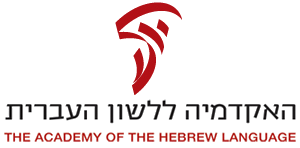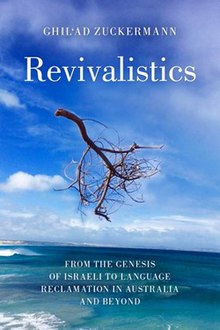False cognates are pairs of words that seem to be cognates because of similar sounds and meaning, but have different etymologies; they can be within the same language or from different languages, even within the same family. For example, the English word dog and the Mbabaram word dog have exactly the same meaning and very similar pronunciations, but by complete coincidence. Likewise, English much and Spanish mucho came by their similar meanings via completely different Proto-Indo-European roots, and same for English have and Spanish haber. This is different from false friends, which are similar-sounding words with different meanings, and may or may not be cognates.
Modern Hebrew has 25 to 27 consonants and 5 to 10 vowels, depending on the speaker and the analysis.

Modern Hebrew, also called Israeli Hebrew or simply Hebrew, is the standard form of the Hebrew language spoken today. Developed as part of Hebrew's revival in the late 19th century and early 20th century, it is the official language of the State of Israel, and the world's only Canaanite language in use. Coinciding with the creation of the state of Israel, where it is the national language, Modern Hebrew is the only successful instance of a complete language revival.
Language revitalization, also referred to as language revival or reversing language shift, is an attempt to halt or reverse the decline of a language or to revive an extinct one. Those involved can include linguists, cultural or community groups, or governments. Some argue for a distinction between language revival and language revitalization. There has only been one successful instance of a complete language revival, the Hebrew language, creating a new generation of native speakers without any pre-existing native speakers as a model.

The Academy of the Hebrew Language was established by the Israeli government in 1953 as the "supreme institution for scholarship on the Hebrew language in the Hebrew University of Jerusalem of Givat Ram campus."

Jewish languages are the various languages and dialects that developed in Jewish communities in the diaspora. The original Jewish language is Hebrew, supplanted as the primary vernacular by Aramaic following the Babylonian exile. Jewish languages feature a syncretism of Hebrew and Judeo-Aramaic with the languages of the local non-Jewish population.

In linguistics, language death occurs when a language loses its last native speaker. By extension, language extinction is when the language is no longer known, including by second-language speakers, when it becomes known as an extinct language. A related term is linguicide, the death of a language from natural or political causes, and, rarely, glottophagy, the absorption or replacement of a minor language by a major language.
Language reform is a kind of language planning by widespread change to a language. The typical methods of language reform are simplification and linguistic purism. Simplification regularises vocabulary, grammar, or spelling. Purism aligns the language with a form which is deemed 'purer'.
Ngarrindjeri, also written Narrinyeri, Ngarinyeri and other variants, is the language of the Ngarrindjeri and related peoples of southern South Australia. Five dialects have been distinguished by a 2002 study: Warki, Tanganekald, Ramindjeri, Portaulun and Yaraldi.

The revival of the Hebrew language took place in Europe and Palestine toward the end of the 19th century and into the 20th century, through which the language's usage changed from purely the sacred language of Judaism to a spoken and written language used for daily life in Israel. The process began as Jews from diverse regions started arriving and establishing themselves alongside the pre-existing Jewish community in the region of Palestine in the first half of the twentieth century. Arabic-speaking Jews in Palestine and the linguistically diverse newly arrived Jews switched to Hebrew as a lingua franca, the historical linguistic common denominator of all the Jewish groups. At the same time, a parallel development in Europe changed Hebrew from primarily a sacred liturgical language into a literary language, which played a key role in the development of nationalist educational programs. Modern Hebrew was one of three official languages of Mandatory Palestine, and after the Israeli Declaration of Independence in 1948, one of two official languages of Israel, along with Modern Arabic. In July 2018, a new law made Hebrew the sole official language of the state of Israel, giving Arabic a "special status".

The Barngarla, formerly known as Parnkalla and also known as Pangkala, are an Indigenous people of South Australia and the traditional owners of much of Eyre Peninsula. Their language, Barngarla is a Yura language and part of a revival effort by the University of Adelaide.

The Battalion of the Defenders of the Language was a small but militant body established by Jewish students at the Herzliya Hebrew Gymnasium in Tel Aviv in the 1920s to urge Jews in then Mandatory Palestine to use only the Hebrew language.

Ghil'ad Zuckermann is an Israeli-born language revivalist and linguist who works in contact linguistics, lexicology and the study of language, culture and identity.

Barngarla, formerly known as Parnkalla, is an Aboriginal language of Eyre Peninsula, South Australia. It was formerly extinct, but has undergone a process of revival since 2012.

Language Contact and Lexical Enrichment in Israeli Hebrew is a scholarly book written in the English language by linguist Ghil'ad Zuckermann, published in 2003 by Palgrave Macmillan. The book proposes a socio-philological framework for the analysis of "camouflaged borrowing" such as phono-semantic matching. It introduces for the first time a classification for "multisourced neologisms", new words that are based on two or more sources at the same time.
The Adelaide Language Festival is a language festival that celebrates linguistic diversity and encourages people to learn about the cognitive and cultural advantages of multilingualism. It consists of keynote presentations, musical performances, Welcome to Country by a local Aboriginal Australian, and intensive sessions in dozens of languages.
Clamor Wilhelm Schürmann was a Lutheran missionary who emigrated to Australia and did fundamental pioneering work, together with his colleague Christian Gottlieb Teichelmann, on recording some Australian languages in South Australia.
In linguistics, polarity of gender is when a lexical item takes the opposite grammatical gender than expected. The phenomenon is widespread in Afroasiatic languages such as Semitic and Cushitic tongues. For example, in Somali, which is a Cushitic language, plural nouns usually take the opposite gender of their singular forms.
Native tongue title is a revivalistic term that refers to compensation for linguicide. Native tongue title is the enactment of a statute-based, ex gratia financial compensation scheme, to cover efforts to resuscitate a heritage tongue that was killed, or to empower an endangered one.









